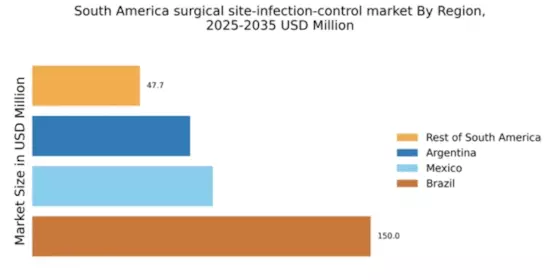The surgical site-infection-control market in South America is characterized by a competitive landscape that is increasingly shaped by innovation, strategic partnerships, and regional expansion. Key players such as 3M (US), Johnson & Johnson (US), and Medtronic (IE) are actively pursuing strategies that emphasize technological advancements and enhanced product offerings. For instance, 3M (US) has focused on developing advanced antimicrobial dressings, which are gaining traction due to their effectiveness in reducing infection rates. Meanwhile, Johnson & Johnson (US) is leveraging its extensive research capabilities to introduce new surgical solutions that integrate digital health technologies, thereby enhancing patient outcomes and operational efficiencies. These strategies collectively contribute to a dynamic competitive environment, where companies are not only vying for market share but also striving to set new standards in infection control practices.
In terms of business tactics, companies are increasingly localizing manufacturing to better serve regional markets and optimize supply chains. This approach appears to be a response to the growing demand for rapid product availability and cost efficiency. The market structure is moderately fragmented, with several key players holding substantial shares, yet leaving room for smaller companies to innovate and capture niche segments. The collective influence of these major players is significant, as they drive trends and set benchmarks for quality and efficacy in surgical site infection control.
In October 2025, Medtronic (IE) announced a strategic partnership with a local South American healthcare provider to enhance the distribution of its infection control products. This collaboration is expected to streamline access to advanced surgical solutions, thereby improving patient care in the region. The strategic importance of this partnership lies in Medtronic's ability to leverage local expertise and networks, which may facilitate quicker market penetration and responsiveness to regional healthcare needs.
In September 2025, B. Braun Melsungen AG (DE) launched a new line of biodegradable surgical drapes designed to minimize environmental impact while maintaining high standards of infection control. This initiative not only aligns with global sustainability trends but also positions B. Braun as a leader in eco-friendly medical solutions. The introduction of these products could potentially attract environmentally conscious healthcare facilities, thereby expanding the company's market reach.
In August 2025, Smith & Nephew (GB) unveiled a digital platform aimed at enhancing surgical site management through real-time data analytics. This platform is designed to provide healthcare professionals with actionable insights, potentially reducing infection rates and improving surgical outcomes. The strategic significance of this digital transformation is profound, as it reflects a broader trend towards integrating technology into healthcare practices, which is likely to redefine competitive dynamics in the market.
As of November 2025, current trends in the surgical site-infection-control market are increasingly defined by digitalization, sustainability, and the integration of artificial intelligence. Strategic alliances among key players are shaping the landscape, fostering innovation and enhancing product offerings. Looking ahead, competitive differentiation is expected to evolve, with a notable shift from price-based competition towards a focus on innovation, technological advancements, and supply chain reliability. This transition suggests that companies that prioritize these elements will likely emerge as leaders in the market.


















Leave a Comment